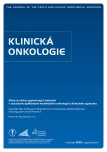Profile of Activation of Tyrosine Kinases and MAP Kinases in Therapy of Maffucci Syndrome
Authors:
K. Melichárková 1; J. Neradil 2,3; P. Múdrý 1; K. Zitterbart 1,3; R. Obermannová 3,5; J. Skotáková 4; R. Veselska 1,2; J. Štěrba 1,3
Authors‘ workplace:
Klinika dětské onkologie LF MU a FN Brno
1; Laboratoř nádorové biologie, Ústav experimentální biologie, PřF MU, Brno
2; Regionální centrum aplikované molekulární onkologie, Masarykův onkologický ústav, Brno
3; Klinika dětské radiologie LF MU a FN Brno
4; Klinika komplexní onkologické péče, Masarykův onkologický ústav, Brno
5
Published in:
Klin Onkol 2015; 28(Supplementum 2): 47-51
doi:
https://doi.org/10.14735/amko20152S47
Overview
Background:
Maffucci syndrome is a rare congenital non‑hereditary disease characterized by multiple hemangiomas and enchondromas, which may progress into malignancy. The causal therapy does not exist, and therapy is aimed at complications. The determination of appropriate therapy is complicated, and a multidisciplinary approach is often essential.
Case:
Authors are presenting the case of a 20‑year‑ old patient with Maffucci syndrome. During her life, multiple enchondromas and progressing hemangiomas have been revealed and they have caused many complications, such as limited movement, growth failure, pain, fluidothorax and ascites. A profile of phosphorylation of selected tyrosine kinases and MAP kinases from progressing hemangioma was performed and with consideration of the result, it led to change of treatment strategy with encouraging clinical response lasting for six months.
Key words:
enchondromatosis – hemangioma – receptor protein-tyrosine kinases – MAP kinases signaling system – individualized medicine – Maffucci syndrome
This study was supported by the European Regional Development Fund and the State Budget of the Czech Republic – RECAMO, CZ.1.05./2.1.00/03.0101, by the project CEB, OP VK CZ.1.07/2.3.00/20.0183 and by the project MUNI/A/1552/2014.
The authors declare they have no potential conflicts of interest concerning drugs, products, or services used in the study.
The Editorial Board declares that the manuscript met the ICMJE “uniform requirements” for biomedical papers.
Submitted:
18. 4. 2015
Accepted:
26. 6. 2015
Sources
1. Verdegaal SH, Bovee JV, Pansuriya TC et al. Incidence, predictive factors, and prognosis of chondrosarcoma in patients with Ollier disease and Maffucci syndrome: an international multicenter study of 161 patients. Oncologist 2011; 16(12): 1771– 1779. doi: 10.1634/ theoncologist.2011‑ 0200.
2. Lissa F, Argente J, Antunes G et al. Maffucci syndrome and soft tissue sarcoma: a case report. Int Semin Surg Oncol 2009; 6(1): 2. doi: 10.1186/ 1477‑ 7800‑ 6‑ 2.
3. Lin PP, Moussallem CD, Deavers MT. Secondary chondrosarcoma. J Am Acad Orthop Surg 2010; 18(10): 608– 615.
4. Park EA, Seo JW, Lee SW et al. Infantile hemangioendothelioma treated with high dose methylprednisolone pulse therapy. J Korean Med Sci 2001; 16(1): 127– 129.
5. Riou S, Morelon E, Guibaud L et al. Efficacy of rapamycin for refractory hemangioendotheliomas in Maffucci’s syndrome. J Clin Oncol 2012; 30(23): e213– e215. doi: 10.1200/ JCO.2012.41.7287.
6. Pasquier E, Street J, Pouchy C et al. β‑blockers increase response to chemotherapy via direct antitumour and anti‑angiogenic mechanisms in neuroblastoma. Br J Cancer 2013; 108(12): 2485– 2494. doi: 10.1038/ bjc.2013.205.
7. Lewis RJ, Ketcham AS. Maffucci’s syndrome: functional and neoplastic significance. Case report and review of the literature. J Bone Joint Surg Am 1973; 55(7): 1465– 1479.
8. Lemmon MA, Schlessinger J. Cell signaling by receptor tyrosine kinases. Cell 2010; 141(7): 1117– 1134.
9. Dorion S, Landry J. Activation of the mitogen‑activated protein kinase pathways by heat shock. Cell Stress Chaperones 2002; 7(2): 200– 206.
10. Pasquier E, Tuset MP, Street J et al. Concentration‑ and schedule‑ dependent effects of chemotherapy on the angiogenic potential and drug sensitivity of vascular endothelial cells. Angiogenesis 2013; 16(2): 373– 386. doi: 10.1007/ s10456‑ 012‑ 9321‑ x.
Labels
Paediatric clinical oncology Surgery Clinical oncologyArticle was published in
Clinical Oncology

2015 Issue Supplementum 2
- Metamizole vs. Tramadol in Postoperative Analgesia
- Metamizole at a Glance and in Practice – Effective Non-Opioid Analgesic for All Ages
- Spasmolytic Effect of Metamizole
- The Importance of Hydration in Wound Healing
- Obstacle Called Vasospasm: Which Solution Is Most Effective in Microsurgery and How to Pharmacologically Assist It?
Most read in this issue
- Adenoviral Vectors in Gene Therapy
- Nrf2 – Two Faces of Antioxidant System Regulation
- Recombinant Antibodies and Their Employment in Cancer Therapy
- What Can Study of Oligomerization of Proteinsin the Process of Oncogenesis Bring Us?
